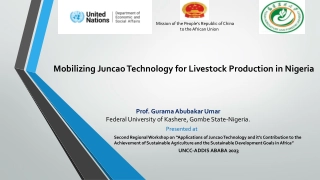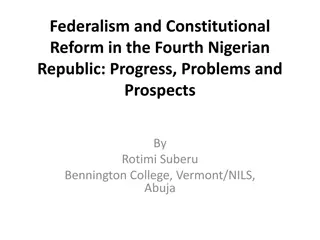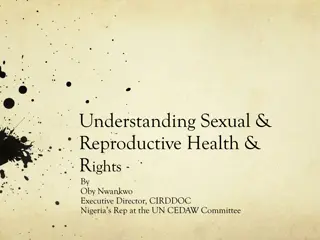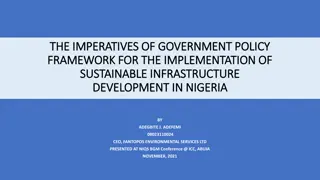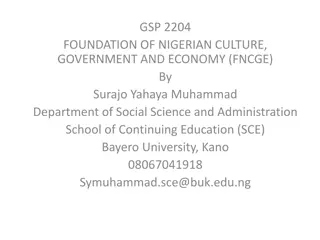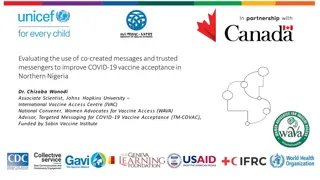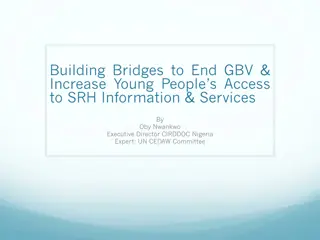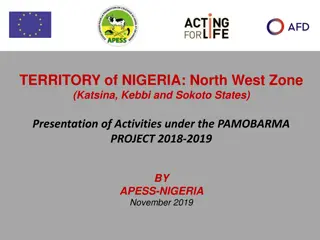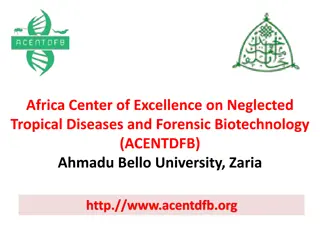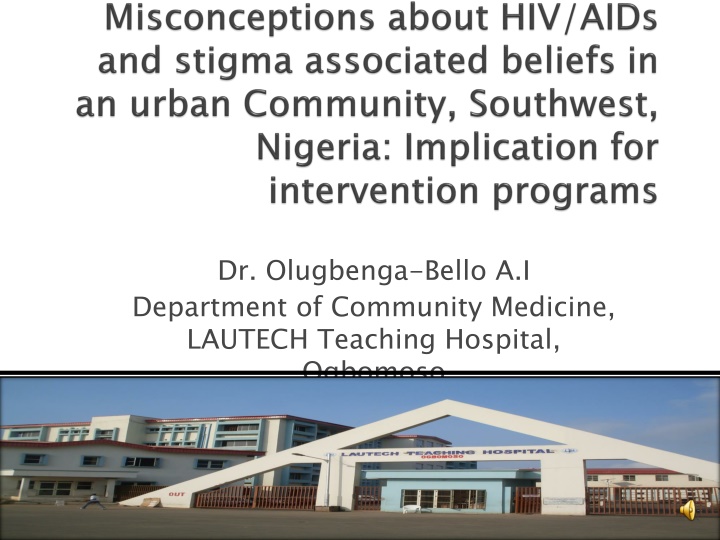
HIV/AIDS Misconceptions and Stigma in Southwest Nigeria
Explore the prevalence of HIV/AIDS in Nigeria, particularly in Osun state, and the societal challenges faced due to stigma and discrimination against PLWHA. A study in Osogbo Local Government Area aims to identify misconceptions, assess awareness, and analyze beliefs about HIV/AIDs in the region. The sociodemographic characteristics of the study population are also detailed, shedding light on factors influencing perceptions and behaviors related to HIV/AIDS in the community.
Uploaded on | 1 Views
Download Presentation

Please find below an Image/Link to download the presentation.
The content on the website is provided AS IS for your information and personal use only. It may not be sold, licensed, or shared on other websites without obtaining consent from the author. If you encounter any issues during the download, it is possible that the publisher has removed the file from their server.
You are allowed to download the files provided on this website for personal or commercial use, subject to the condition that they are used lawfully. All files are the property of their respective owners.
The content on the website is provided AS IS for your information and personal use only. It may not be sold, licensed, or shared on other websites without obtaining consent from the author.
E N D
Presentation Transcript
Dr. Olugbenga-Bello A.I Department of Community Medicine, LAUTECH Teaching Hospital, Ogbomoso
Nigeria is located in West Africa, with an estimated 3.7 percent of the population living with HIV (VERT, 2012) http://4.bp.blogspot.com/-ZMlqIX0fATw/T1c9U4T_TFI/AAAAAAAAAn4/gFefw5690F0/s400/biz1.jpg The prevalence rate varies across the country, ranges from 0.2-15.2% Osun state has a prevalence of 2.7% as at 2012 survey Worldwide, Nigeria has the second highest number of new infections reported each year,
Stigma and discrimination against PLWHA are obstacles in the way of effective responses to the HIV epidemic It complicates decisions about testing, Unwilling disclosure of HIV status, ability to negotiate prevention behaviours, including use of family planning services, PMTCT etc With the associated social issues-loss of marriages, livelihood etc
To identify misconceptions about HIV/AIDs and stigma associated beliefs in an urban Community, in Southwest, Nigeria To determine respondent awareness and knowledge on HIV/AIDs. To assess the beliefs of the respondents about HIV/AIDs
Study Area Study design: Cross sectional descriptive survey Study population: Adult men and women in Osogbo Local Government Area of Osun state Sampling technique : Multi stage sampling technique Calculated Sample size : 501 Data collection: quantitative Data management: Using SPSS version 17,0 Study Area: Osogbo metropolis in Nigeria Study design Study population Sampling technique Calculated Sample size Data collection: quantitative Data management: Using SPSS version 17,0
SOCIODEMOGRAPHIC CHARACTERISTICS N = 449 AGES (YEARS) Less than 21 21-30 31-40 41-50 51-60 61 and above SEX Male Female OCCUPATION Professional Unskilled Artisan Trader Farmer Schooling Unemployed EDUCATION STATUS Primary Secondary Tertiary Uneducated RELIGION Christian Muslim Traditional MARITAL STATUS Single Married Divorce Separated FREQUENCY PERCENTAGE (%) 41 188 99 88 28 9.1 41.9 22.0 19.6 6.2 0.9 5 177 272 39.4 60.6 236 19 22 27 52.6 4.2 4.9 6.0 0.7 26.7 4.9 3 120 22 30 72 340 6.7 16.0 75.7 1.6 7 321 123 71.5 27.4 1.1 5 180 265 40.1 59.0 0.7 0.2 3 1
N = 449 VARIABLES Ever heard of HIV/AIDS HIV/AIDS can be transmitted through; kissing N = 449 VARIABLES FREQUENCY (PERCENTAGE) NO FREQUENCY (PERCENTAGE) NO YES YES NOT SURE NOT SURE 438(97.6%) 10(2.2%) 1(0.2%) 208(46.3%) 204(45.4%) 37(8.3 %) Hugging 114(25.4%) 295(65.7%) 40(8.9%) Toilet sharing 129(28.7%) 271(60.4%) 49(10.9%) Sharing of cup and spoon 132(29.4%) 272(60.6%) 45(10%) Know any symptoms of HIV/AIDS 254(56.6%) 151(33.6%) 26(5.8%) Know anyone with HIV/AIDS 46(10.2%) 376(83.7%) 19(4.2%) HIV/AIDS is curable 102(22.7%) 219(48.8%) 128(28.5%) It is a spiritual attack 40(8.9%) 332(73.9%) 78(17.4%)
N=449 VARIABLES FREQUENCY(PERCENTAGE) YES NO NOT SURE Perception about HIV/AIDS HIVAIDS is an act of God s punishment 111(24.7%) 245(54.6%) 68(15.1%) Sex Education help prevent HIV/AIDS 397(88.4%) 32(7.1%) 20(4.5%) The use of condom prevent HIV/AIDS 290(64.6%) 80(17.8%) 79(17.6%) Abstinence is the best means of prevention 310(69%) 70(15.6%) 69(15.4%) Done HIV testing before 240(53.5%) 209(46.5%) 0 (0%)
VARIABLES (N=449) FREQUENCY (PERCENT) YES NO NOT SURE 147(32.7%) PLWHA are promiscuous 130(29.0%) 172(38.3%) can still live a normal life can live with PLWHA 357(79.5%) 57(12.7%) 35(7.8%) 380(84.6%) 40(8.9%) 29(6.5%) Suicide is the best option for PLWHA 50(11.1%) 370(82.4%) 29(6.5%) can be a friend with PLWHA 340(75.7%) 67(14.9%) 42(9.4%) can employ PLWHA 315(70.2%) 76 (16.9%) 52(11.6%) can allow PLWHA to treat you 162(36.1%) 215(47.9%) 72(16.0%) PLWHA can get married 245(54.6%) 140(31.2%) 64(14.2%) PLWHA should be secluded from the society 74(16.5%) 333(74.2%) 42(9.3%)
N=449 VARIABLE FREQUENCY PERCENTAGE Statistics WRONG PERCEPTION RIGHT PERCEPTION X 2 P values Age group ( in years Less than 20 21-30 31-40 41-50 51-60 61 and above Gender Male Female Occupation Professional Unskilled Artisan Trader Farmer Schooling Unemployment Educational Status Primary Secondary Tertiary Uneducated Age group ( in years) ) 13(9.5%) 58 (42.4%) 34(24.8%) 24(17.5%) 5(3.6%) 3(2.2%) 10(6.6%) 82(53.9%) 39(25.7%) 10(6.6%) 10(6.6%) 1(0.2.366%) 4.657 P=0.142 Gender 55(40.1%) 82(59.9%) 76(42.7%) 102(57.3%) 6.207 P=0.253 Occupation 63(46.0%) 13(9.5%) 11(8.0%) 11(8.0%) 3(2.2%) 33(24.1%) 3(2.2%) 100(56.4%) 2(1.1%) 8(4.5%) 4(2.2%) 1(0.3%) 53(29.8%) 10(5.6%) 27.256 P=0.142 Educational Status 11(8.0%) 33 (24.1%) 90(65.7%) 3(2.2%) 5 (2.8%) 23 (12.9%) 149(84.0%) 1(0.3%) 16.987 P=0.001
occupation (constant=professionals group) education (constant= uneducated) Knowledge of any symptoms of HIV/AIDS OR=0.66, 95%CI=0.5010- 0.8660, p=0.012 OR= 1.85, 95%CI=1.3804- 2.4910, p=0.013 Agreed that the use of condom prevent HIV/AIDS OR=0.31, 95%CI=0.2244- 0.4164, p=0.001 OR=0.96, 95%CI=0.6185- 1.1947, p=0.6105 Have done HIV testing before OR=0.96, 95%CI=0.7424- 1.2540, p=0.7360 OR=2.72, 95%CI=2.0438- 3.6102, p=0.2024 Said that PLHIV should be secluded from society OR=4.99, 95%CI=3.6471- 6.8161, p=0.119 OR=0.66, 95%CI=3.3670- 5.1516, p=0.4971
High level of awareness due to mass media campaigns on HIV/AIDs globally, similar to myler et al in South- Africa,2006. Misconceptions about HIV transmission are high as significant proportions said HIV could be transmitted through kissing, hugging e.t.c Similar misconceptions was reported by Unnikrishnan et al in india. This if unchecked can serve as a barrier to uptake of HIV services.
There was significant association between the level of education and positive perception about PLHIVs This implies that education is important in provision of care and support to PLWHA especially at the community level This is similar to reports from other study in Ethiopia by lifeson et al.
There is high awareness about HIV in Nigeria, with education being a predictor of correct perception about HIV and PLWHA However, there is a an appreciable proportion of the population with misconception, discriminating and stigmatizing beliefs about people living with HIV There is urgent need to improve the contents of information aired on the mass media to ensure that correct information is given out to the people
Comments and contributions. Comments and contributions. 15


